Designing an App for Slack Themes
Can we not only design a web app, but plan and build one as well? Sure we can!
About a year and a half ago, I began to realize I had too many Slack workspaces and had a difficult time differentiating between them. So I set out to build a web app to help collect a bunch Slack Themes where users are able to copy and paste into Slack - you can find it here!
Sidenote: I'm not going to delve too much into the code or design, but if you have questions, feel free to look at the repo on GitHub or contact me!
Slack gives us a way to customize the theme of each workspace sidebar, and I thought this could be a neat way for others to help personalize and identify their different workspaces.
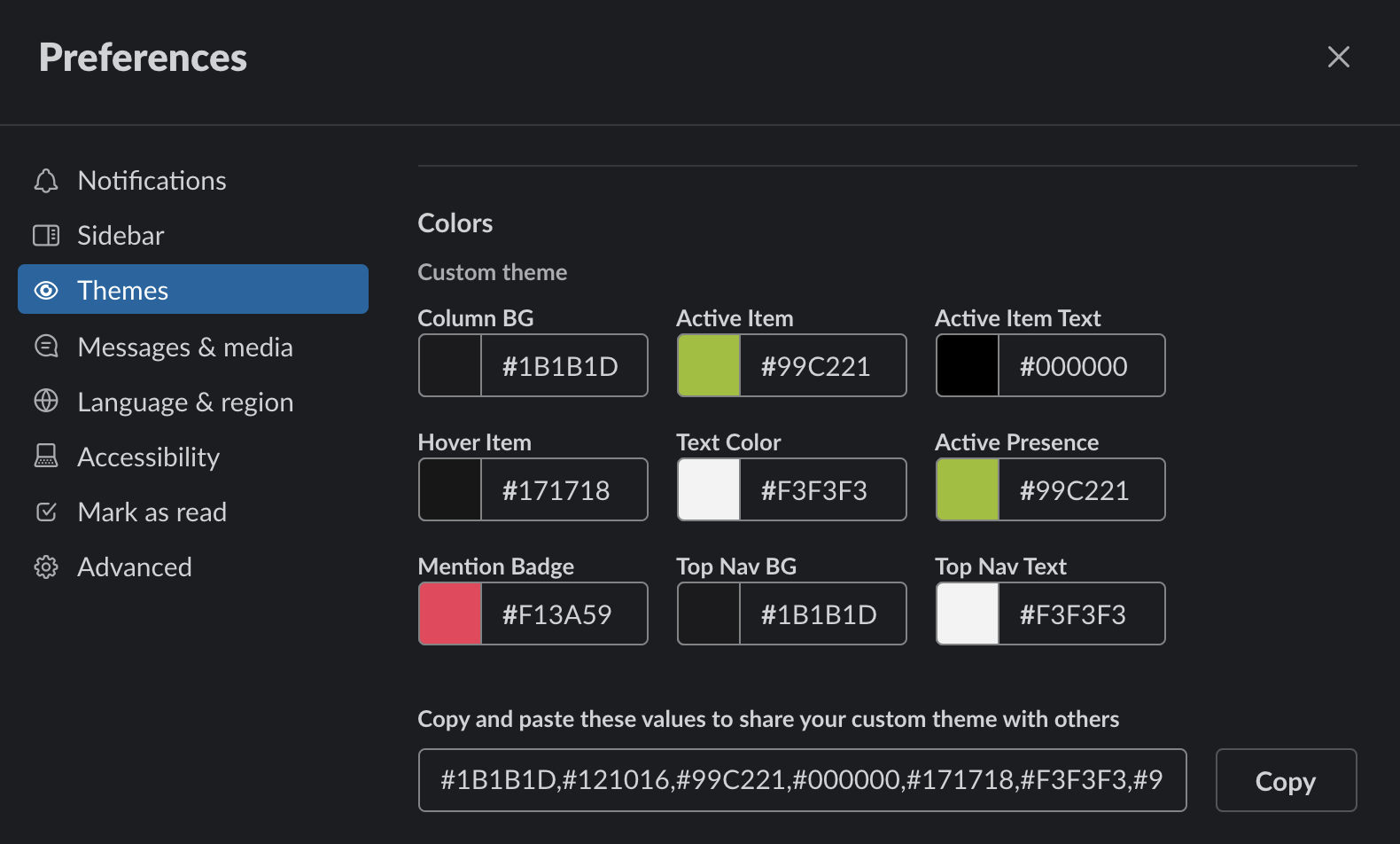
But, in order to change a theme, I had to go through multiple steps: open the menu, click preferences, change theme.
- How can we make the process of selecting themes simpler?
- What if a user wanted to do this in less steps?
- What if a user wanted access to more themes and options?
End Goal
Let's set out to build a web application where users can find one of many curated themes to copy and paste quickly in their Slack workspaces
Although there was a v1 of this web application, I'm going to go through the high-level steps of how I set out to build v2 from the ground up.
What will we use to build it?
- Figma: to help design our idea
- React & Next.js: to house all of our front-end logic and server-rendered pages
- Tailwind: to help build styles super quickly (and a bit of Styled Components)
- Firebase/Firestore: to help house all of our themes inside of a database
There are a few other things, like framer-motion and PostCSS, but they won't be necessary.
Getting Started with Data and Firestore
The first thing we should probably do is start to think how we will store our themes and which types of data will be associated with each theme:
- Theme name
- Theme colors
- Created by
- Date created
- Categories/groups
- Likes
Slack gives us the ability to customize 9 colors in a theme, all denoted by a label (eg. Active Item). Why don't we take a look at a data object of a theme that contains the items listed above:
// theme object{ theme_name: 'Example Theme', active_item: '#5469D4', active_item_text: '#FFFFFF', active_presence:'#4CAF50', column_bg: '#191D27', hover_item: '#283040', mention_badge: '#F2453D', text_color: '#DEE5EE', top_nav_bg: '#000000', top_nav_text: '#DEE5EE', categories: ['dark', 'brand'], likes: 0, submittedBy: 'Ryan Parag', created: 1608255573}Now let's take a look on how to use and insert this data inside Google's Cloud Firestore. If you've never used Firebase/Firestore, you would first have to create a new project before setting up a database inside the project. Here's a step-by-step tutorial on the setup
After you've created a new project, we would need to enable Cloud Firestore as a databse. Here's a quick glance at mine, along with the how we would structure our data (collections and documents):
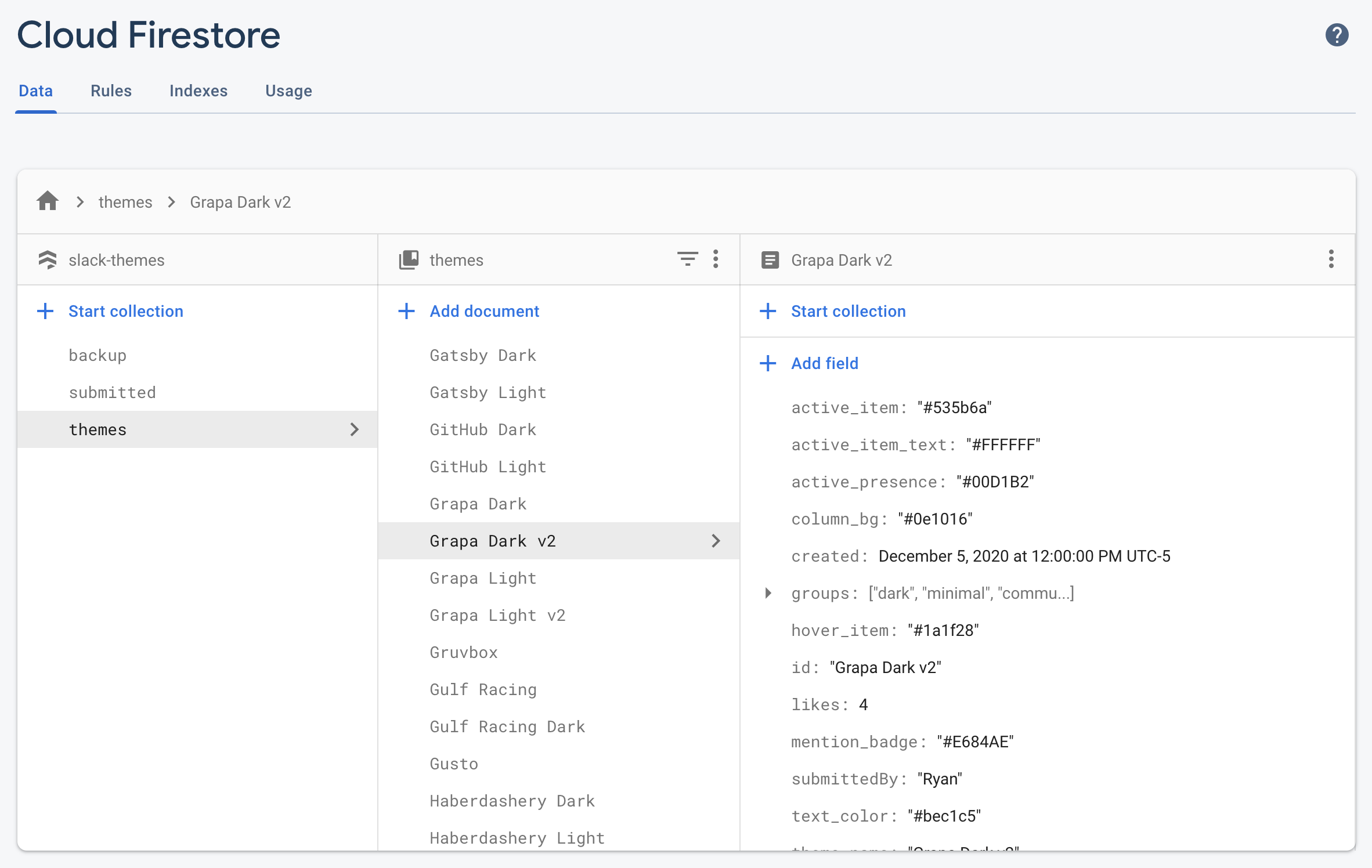
Firestore gives us a few functions to add/edit/delete themes (documents) that we'll use across our app.
Example functions:
// Add an item to a collectionconst addTheme = (Theme) => { firebase.firestore() .collection(YourCollection) .doc(Theme.Id) .set(Theme)}// Delete an item from a collectionconst deleteTheme = (Theme) => { firebase.firestore() .collection(YourCollection) .doc(Theme.Id) .delete()}// Update an item in a collectionconst updateTheme = (Theme) => { firebase.firestore() .collection(YourCollection) .doc(Theme.Id) .update(Theme)}Designing the App
Now that we have a place to store and grab our themes, we need to think about how we would design an easy-to-use interface for our stored themes.
What would each theme look like?
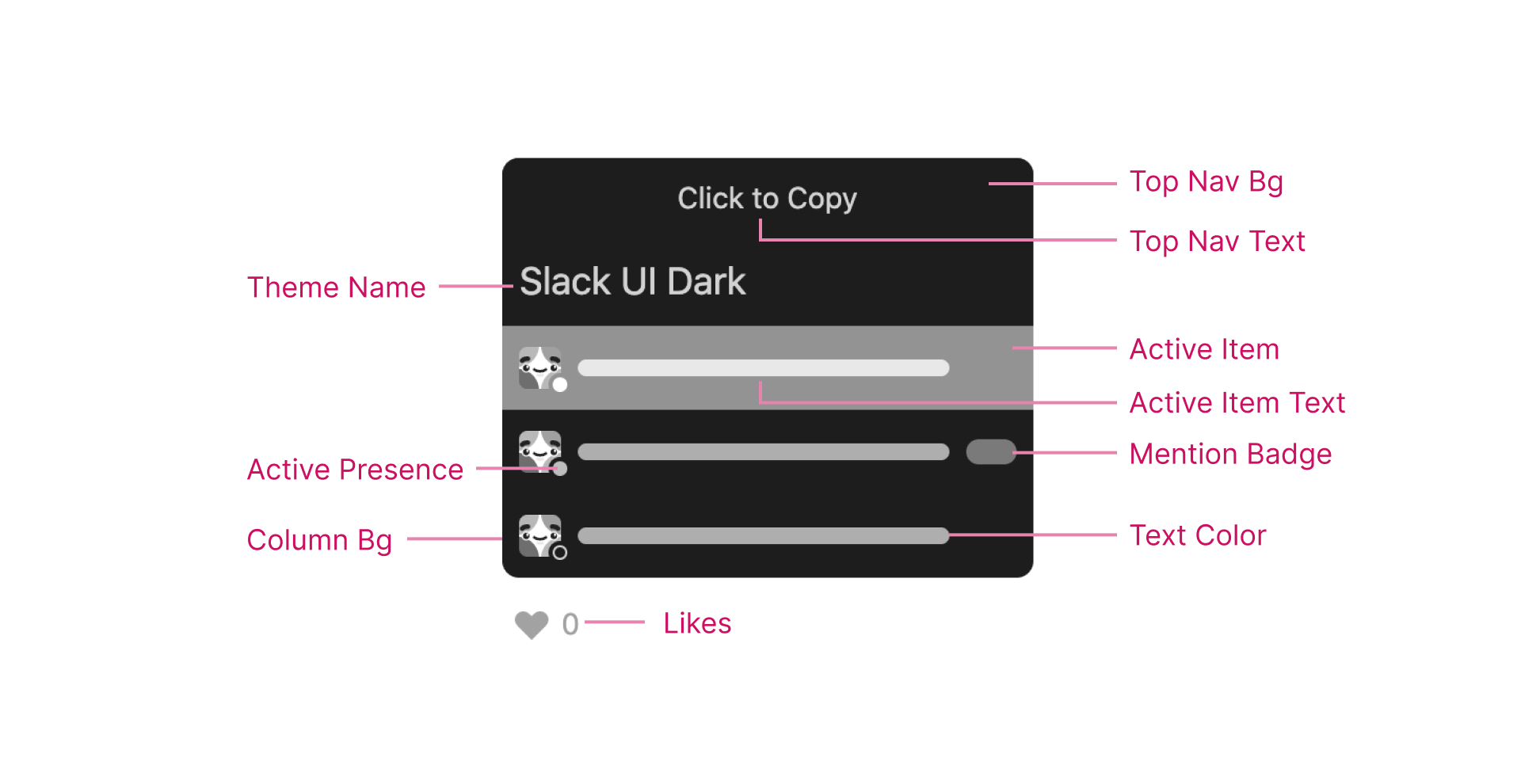
We can also let users copy the string of hex colors easily by clicking each theme card - where the user would subsequently paste into Slack and click the button that Slack generates to switch themes.
Filtering and Sorting
How do we expect users to find themes that fits into their exploring criteria? Would they be searching for dark themes? Or purple themes? Would they be expecting to sort alphabetically or by which themes are most popular?
Since each theme has a set of groups/categories, we can build sets of filters and sorting mechanisms to make the UI for theme browsing flexible.

In order to get our group filtering to work with our data in Firestore, we'll need to build a few indexes - these will help get our complex data query really fast:
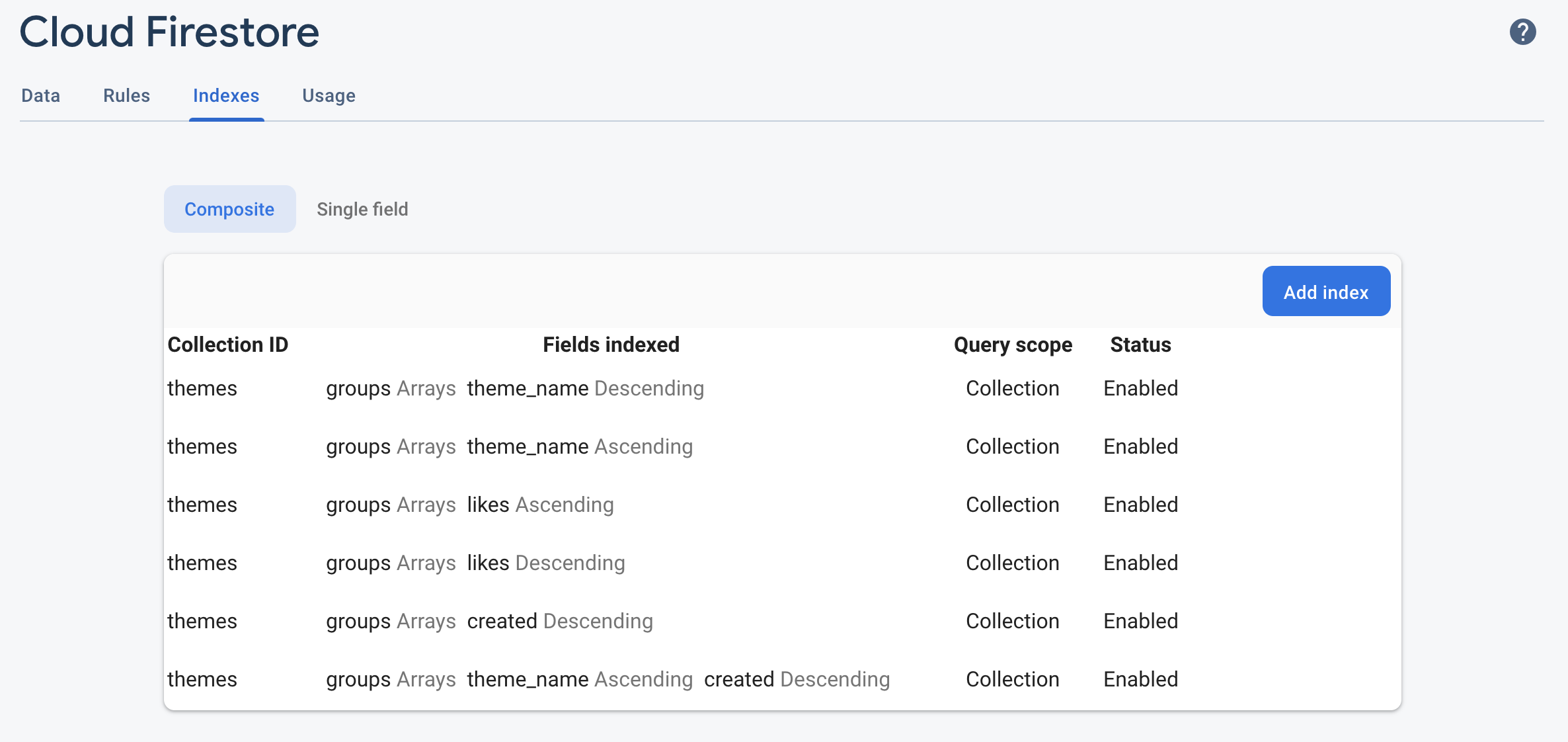
Designing for Low Data
How do we design an app for users who may not have the fastest internet or may have a lesser-performing device?
To help lessen the load from the browser and network connection, we can limit how much data we pull with our Firestore query. Here's what that query looks like in React:
const [loadedThemes, setLoadedThemes] = useState([]) // initial array of themes const [sort, setSort] = useState('theme_name') // initial sorting (by theme_name or likes) const [order, setOrder] = useState('asc') // initial sort order const [queryAmount, setQueryAmount] = useState(27) // initial amount of themes
firebase.firestore().collection('themes').limit(queryAmount).orderBy(sort, order).onSnapshot(snapshot => { const fetchedThemes = snapshot.docs.map((doc) => ({ id: doc.id, ...doc.data() })) setLoadedThemes(fetchedThemes) })We can let users look at the next set of data by creating a button that increments the query limit:
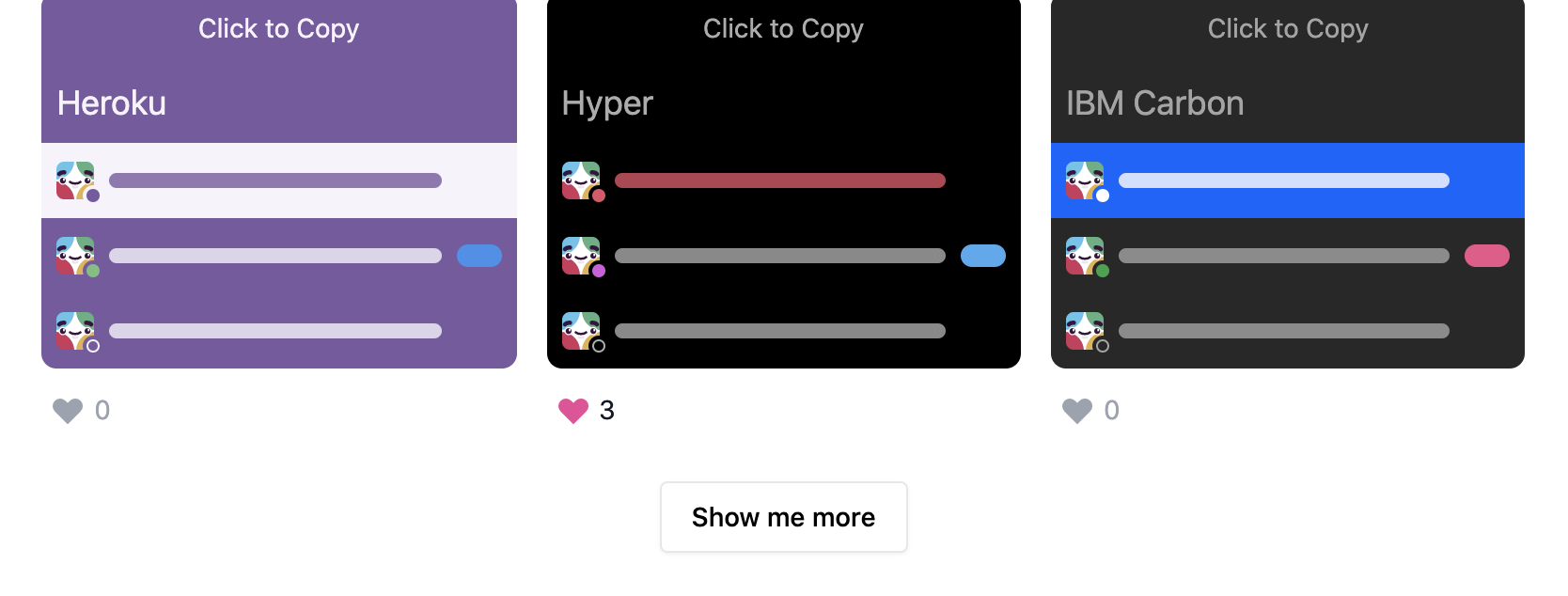
const updateQueryAmount = () => { setQueryAmount(prev => prev + 27) }
...
<button onClick={updateQueryAmount} > Show me more </button>So we've finished our storage, design, and data transformation - let's take a look at what we have:

Designing Options
On top of letting users browse and copy Slack themes, I wanted to give users a way to fine tune the listed themes to better fit how they would like to visualize them:
- Toggle the intrusive Top Nav Bg color to help make each theme a bit more minimal
- Toggle the Theme Name in the copied theme (this would help label the theme when pasting to a thread)
Let's design a space where users may toggle those settings:
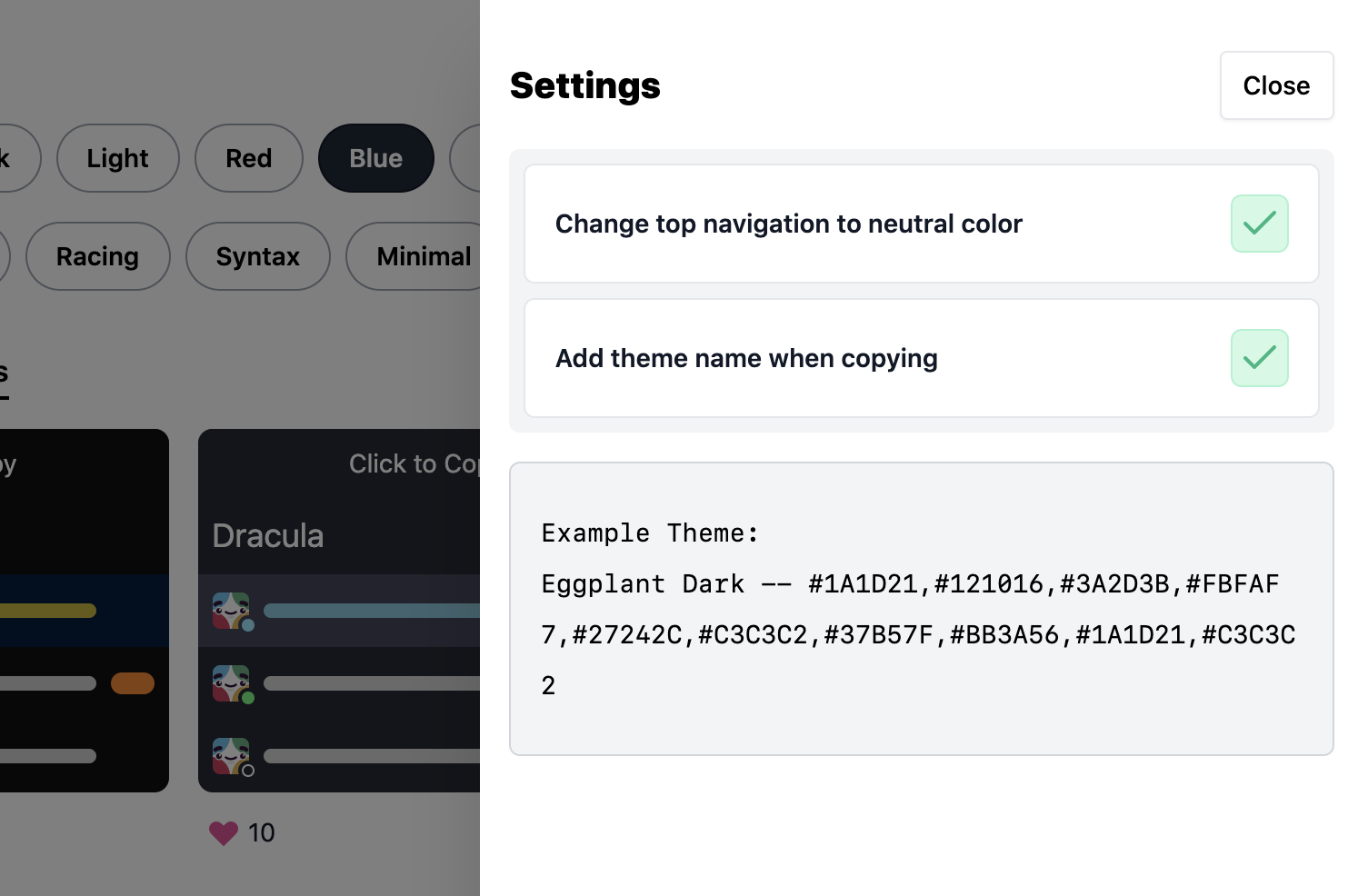
Collecting Submissions
What if a user has a great idea for a theme and wants to add it to our list?
Why don't we design a way for a user to easily submit a theme through our web app? We'll need to ask the user for a few things:
- What colors are in your theme?
- What do you want to call your theme?
- Let us know who you are - to give you credit, of course
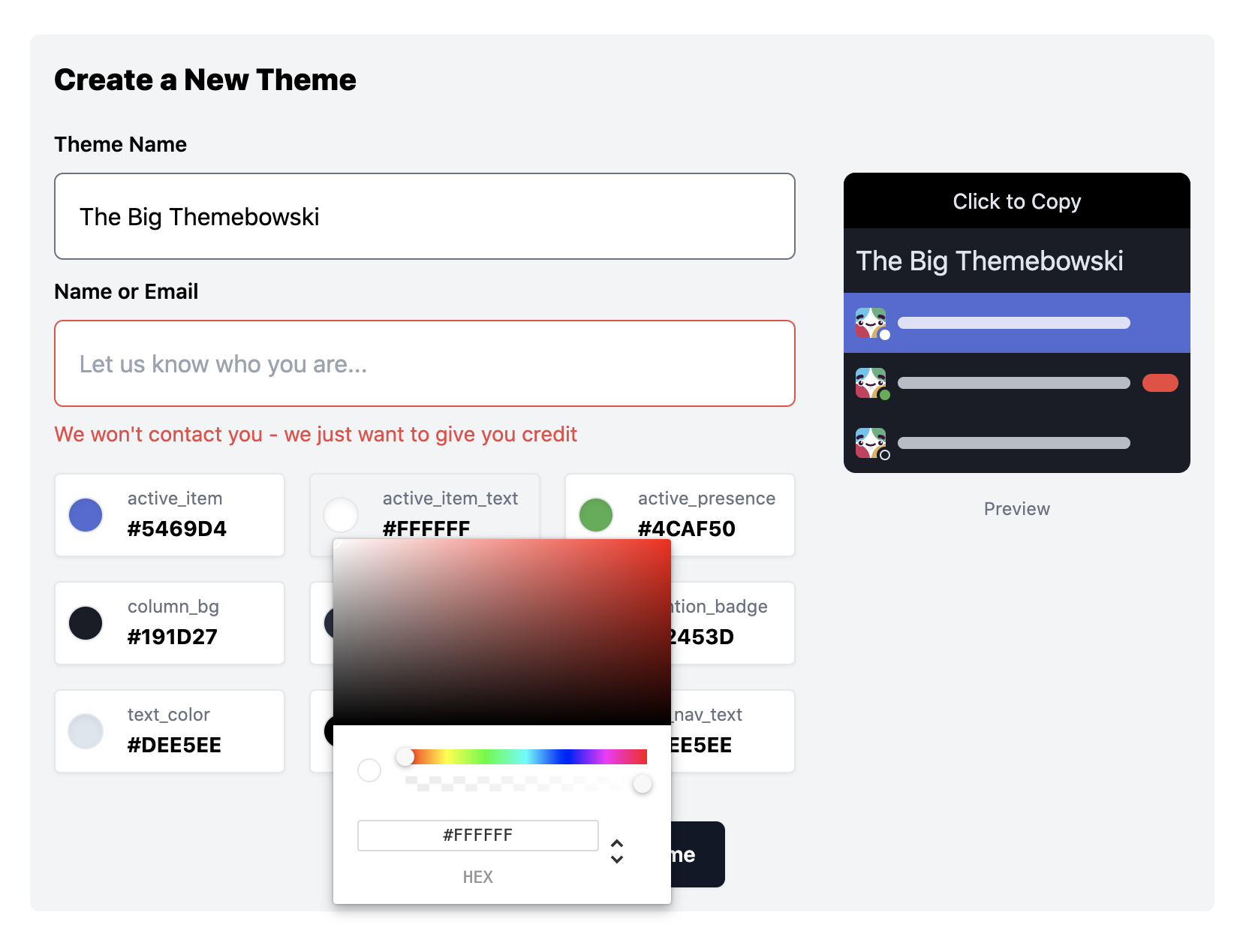
Once submitted, we can add this to another Firestore collection (called submitted) in order to await our verification (we'll go over that a bit later).
Building Engagement
Besides giving users the ability to upvote themes, we can also list a few of the most recently submitted themes:
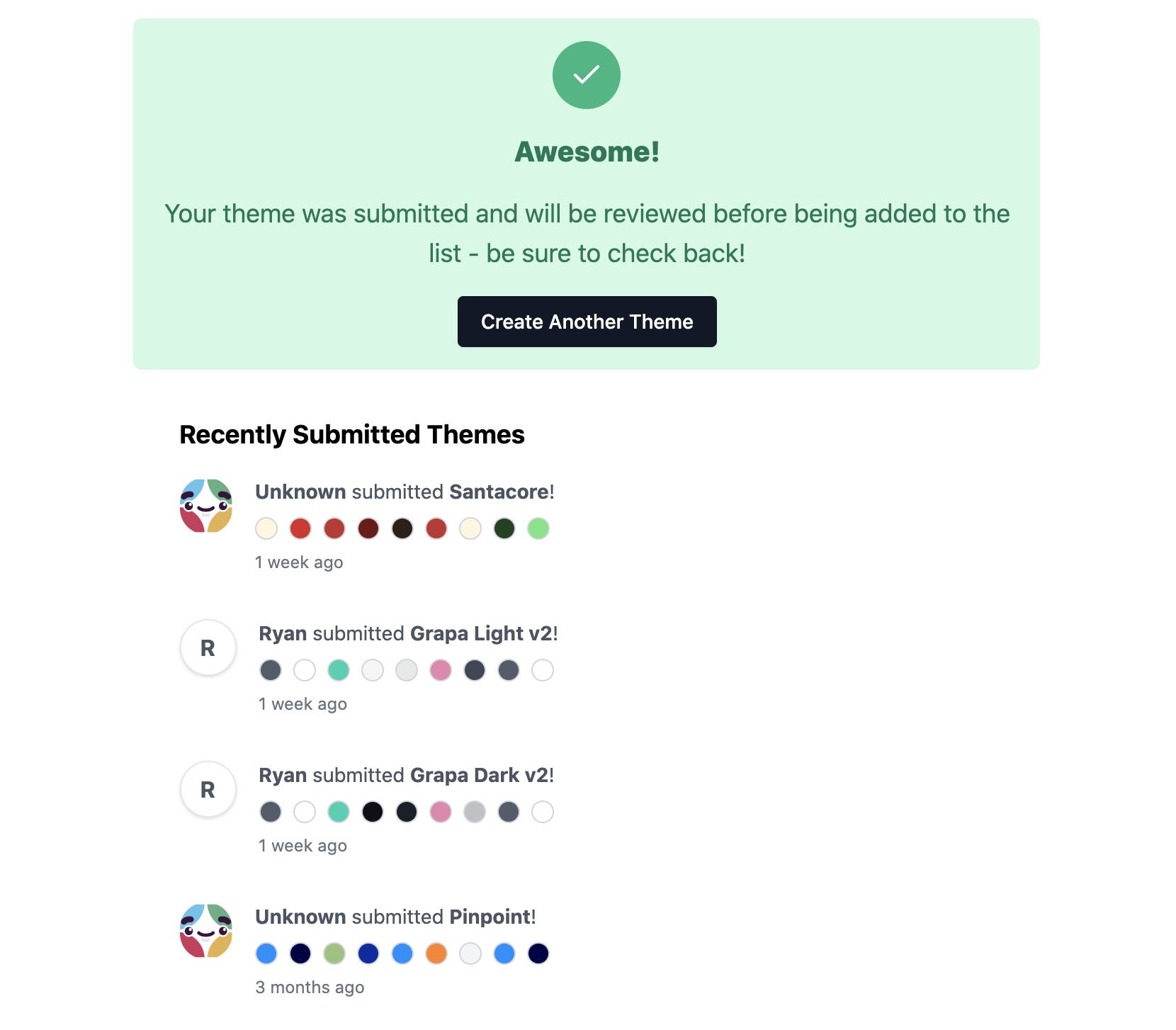
All done! or are we?
Behind the Scenes
I don't want to have to manage theme submissions or editing through Firestore or by pushing new code. If we have all of our data in Firestore, we could design an easier way to update this data through our web app - all hidden behind some user authentication.
What would a scenario for this look like?
- User submits a new theme via our new theme submission form
- Theme gets added to our submitted collection in Firestore
- I have to go into Firestore and manually move new theme from submitted to themes collection
Rather than do this in Firestore and entering this theme into the themes collection manually, we could setup a todo list of sorts in an Admin page on our website.
To do this, I used:
- Firebase Auth: authenticate our admin logins
- Nookies: create authenticate tokens for server-side apps
Login Page
We need a space for admins to login to the admin dashboard. Instead of walking through each step of setting up firebase/auth and nookies, here's a tutorial you can follow to do just that.
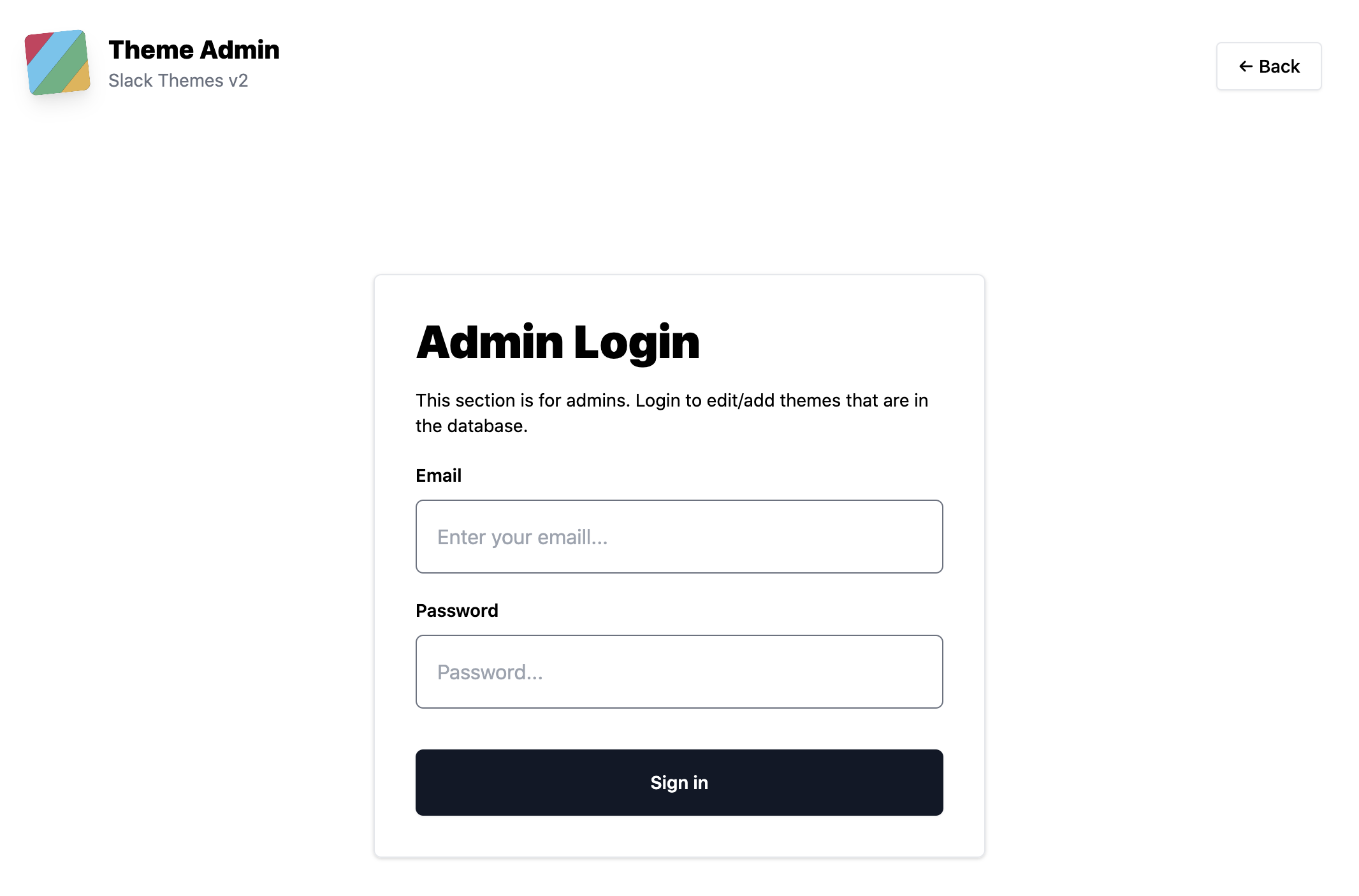
Dashboard
Once logged in, what do need to display and how do we display to build context around our scenario?
We basically need a way to manage the different collections in our database, so why don't we build a simple navigation separating them?
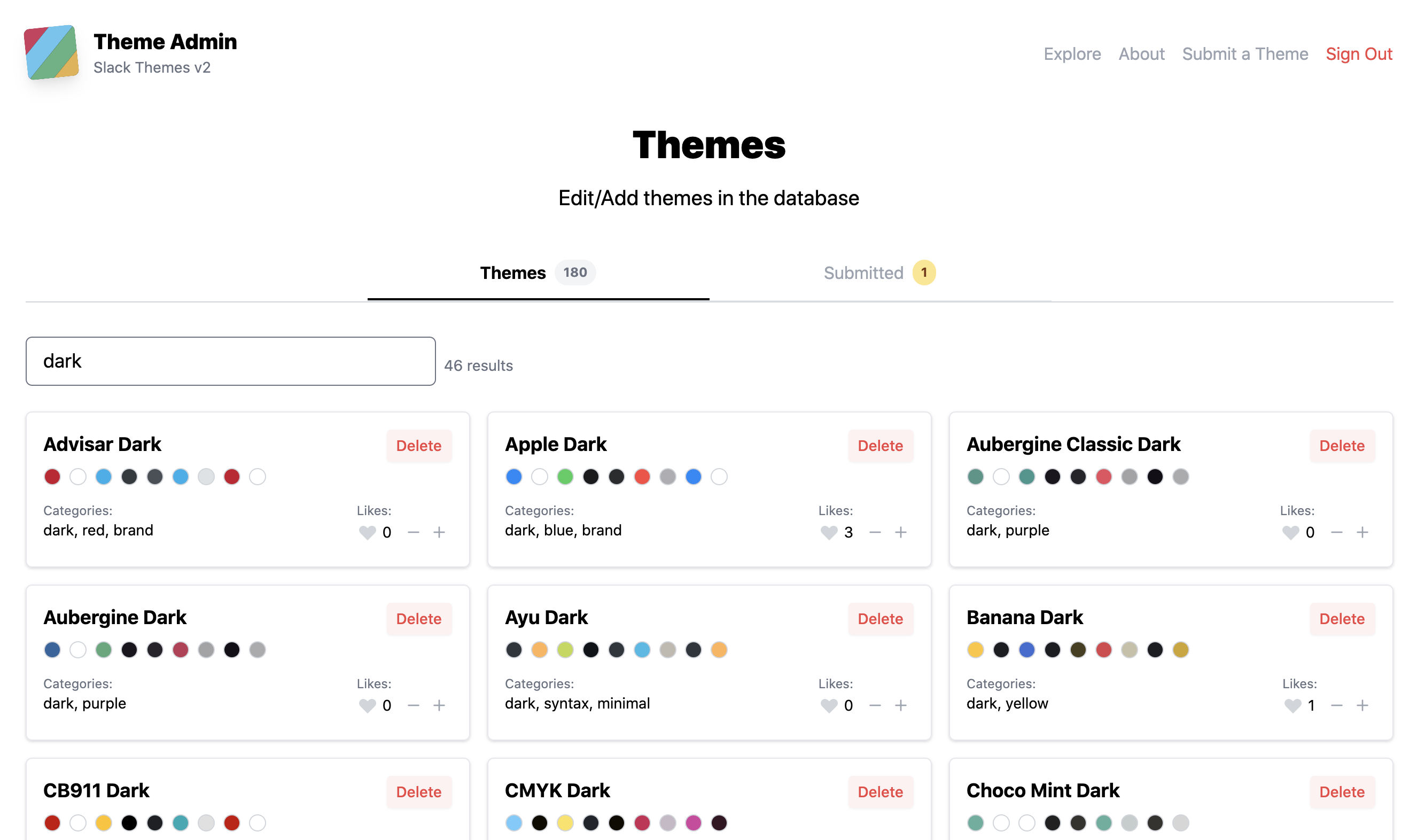
From the image above, it seems as though there's a theme submission awaiting to be verified. We can view the submission as well as associate any groups we feel are suitable for the respective theme:

Once we make any edits, we can click Verify & Transfer to move the submission from our submitted collection to our themes collection.
That's it, for now
This is as far as I've made it, but now that we have our data in Firestore, my next objective is to design an experience for an integrated Slack app - rather than copy/paste themes, we could give users the ability to get a theme directly from a / command!
I didn't delve too much into the code or design here, but if you have questions, feel free to look at the repo on GitHub or contact me using the details below!

